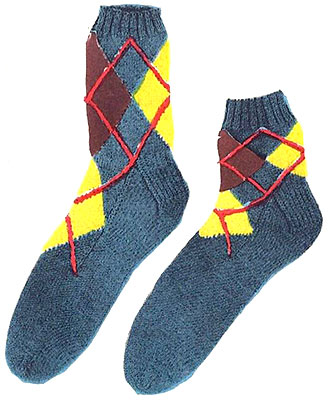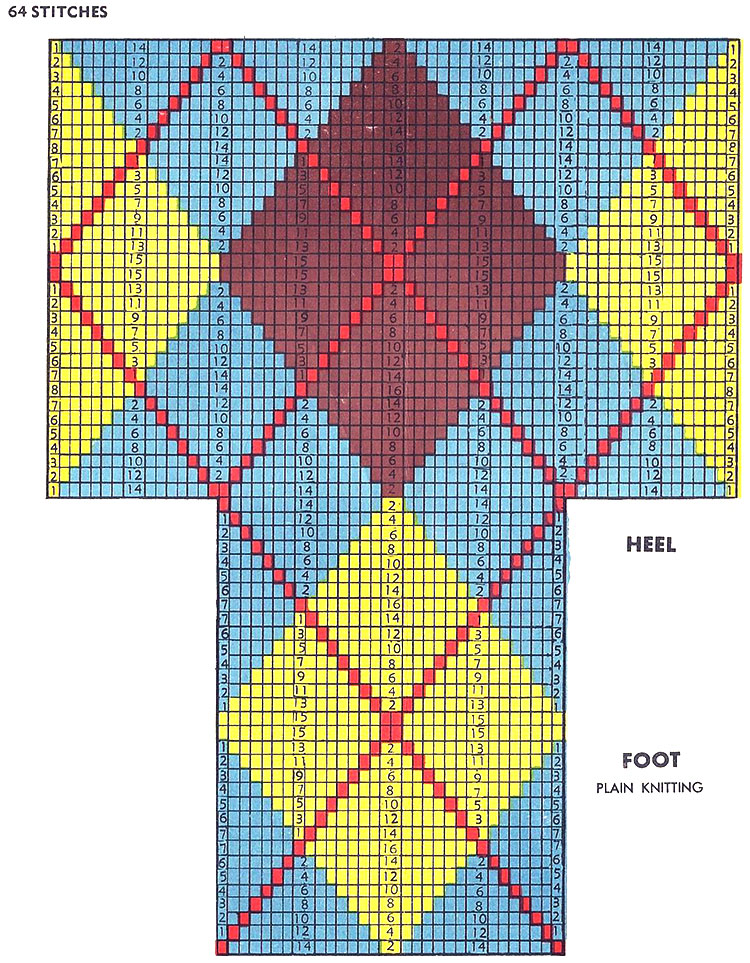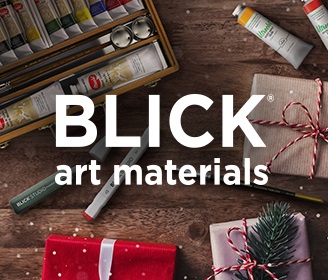Argyle Slack Socks or Anklets Pattern #6401L

Simplified multi-color knitting with color charts. Stitch sequences numbered. Each row knitted across and purled back in the same colors.
Knit right and left socks, if you wish. Sizes 8 to 10½.
IMPORTANT
Knit across and purl back each row before starting next row. Use size NUMBER ONE needles. Knitting tension should be tight enough to produce about 10 stitches per inch. If you do not obtain this gauge, then change to larger or smaller needles as your particular knitting tension requires. The size needle does not matter as long as the stitch gauge attained is correct. (Note: 10 stitches per inch means 'as knit', without allowance for blocking. Socks then block to about 9 stitches per inch on usual size dryers, and will cling snugly to the leg when worn.) Use your own choice of yarn colors.
DIRECTIONS
(It is preferable that the knitter be familiar with basic knitting instructions pertaining to plain socks. However, directions herein are complete, including recommended methods for heel and toe which place sewed seams at side of foot to insure wearing comfort. Free detailed instructions on how to knit, purl, etc., should be obtainable from your yarn shop.)
SLACK SOCKS
MATERIALS—(Note: Different brands of yarn vary in yardage. The following yarn quantities, per pair of socks, are approximate only.) 1½ oz. basic color (aqua), ¼ oz. yellow diamonds, ¼ oz. brown diamond, 6 yds. coral over-stripes. Socks illustrated are 5 inches long above top of heel, including 1 inch of ribbing. If longer socks are desired, add ribbing. Use No. 1 sock needles, double pointed and regular 3-ply sock yarn.
IMPORTANT—Use needles and yarn in these sizes in order to achieve proper size sock per this pattern. Note: It is well to carry your yarn in small quantities of each color, on bobbins which dangle clear of your work, avoiding entanglement. Thus you need 9 bobbins at the first row, for the 9 colors occurring in separated groups as follows: yellow, aqua, coral, coral, brown, aqua, coral, coral, yellow. One bobbin would do for the adjacent coral stitches on the first row, but since these stripes separate as pattern progresses, 2 bobbins will actually be required at this point. (In 2 places). Use one bobbin only, to knit the series of aqua stitches which are interrupted only by the coral over-stripes. Simply carry the yarn across the wrong side of the interrupting coral stitch. (Carry across 2 coral stitches in the first row).
LEG PATTERN—This part of sock is knitted in a flat piece, eventually to be folded and sewed together up the back. First cast on 64 stitches of basic color and knit 2, purl 2, for ribbing of 1 inch. Knit first row as shown in graph, that is 1 yellow, 14 aqua, 2 coral, 14 aqua, 2 brown, 14 aqua, 2 coral, 14 aqua, 1 yellow. These numbers are indicated on graph to save counting squares. In changing colors always twist yarns around each other once to avoid leaving a hole. Now turn and purl back on this same row, using the same colors in the same places. Now knit row No. 2 in the indicated color sequence—2 yellow, 12 aqua … etc., and purl back as before. Continue thus for 32 rows, after which work separates into instep and heel.
INSTEP—Divide the 64 stitches, taking 16 off each end, place on separate needles or stitch holders to work later (will be the heel). Now continue pattern down the instep of the sock using only the 32 center stitches. First row is 1 coral, 14 aqua … etc. Continue to end of pattern. Now discontinue work on this part of sock and knit the heel.
HEEL—(Reinforced type)—Place the 2 groups of 16 stitches, previously divided from the instep pattern, on one needle. This folds the main pattern, or leg of the sock, into position for sewing up the back later. Now slip 1, knit 1 in sequence for the first row, then purl back. Continue thus in successive rows for 1¾ inches. On the last row purl 18 stitches then purl 2 together and purl 1. Turn work. Then:
Knit back 6, knit 2 together, knit 1, turn.
Purl back 7, purl 2 together, purl 1, turn.
Knit back 8, knit 2 together, knit 1, turn.
Purl back 9, … etc.
Knit back 10, … etc.
… Etc.
Continue in this manner, making rounded bottom of heel until all stitches are used up, work then being all on one needle across bottom of heel. Now pick up stitches along the forward edges of the heel thus knitted, and add to the work in progress. About 17 or 18 stitches should be added on each side of the 1¾ inch long heel. Place all stitches evenly divided on 2 needles. Now proceed to knit a row, purl a row, alternately, and decrease on 1 stitch on each side of the foot on each knit row only. When only 32 stitches remain on these 2 underfoot needles, continue without decreasing until this underfoot part is of necessary length to even-up with instep pattern previously completed.
TOE—Join all work together on 3 needles, keeping the 32 stitches on the one needle, 16 stitches each on the 2 underfoot needles. Continue plain knitting round and round until 2¼ inches from the desired length of foot. At this point start decreasing to shape toe, as follows: Decrease 4 stitches on the next row, these being the end stitches on the instep needle, and the stitches next to these, one on each underfoot needle. Knit 4 rows plain then 1 row decreasing 4 stitches as before, 3 rows plain, 1 decreasing, 3 plain, 1 dec., 2 plain, 1 dec., 2 plain, 1 dec., 1 plain, 1 dec., then decrease every row until only 16 stitches remain (8 on instep needle and 4 on each underfoot needle.) Weave toe as follows: Place yarn in a tapestry needle and, with yarn coming from back of knitting needle, put it in first stitch of front (instep) needle as if to knit and slip it off. Then put it in the next stitch of front needle as if to purl and leave it on. Go to back (underfoot) needle and insert as if to purl and take it off, then to next stitch of back needle as if to knit and leave it on. This designation may assist:
Front needle K—off, P—on
Back needle P—off, K—on
Repeat thus to the end of the 8 stitches on each needle.
FINISH—Sew sock up the back, using corresponding color yarn and tapestry needle. Sew foot of sock up each side where instep pattern was knitted separately from lower foot in that area. Finish inside of sock by weaving any thread ends into nearby seams, trimming ends, etc. Block socks on dryers of proper size.
ANKLETS
MATERIALS—Only approximately 1 oz. of basic color aqua is required for a pair of anklets. Other colors also somewhat less than noted for slack socks. Anklet is 3" long above top of heel.
LEG PATTERN—The pattern is handled in exactly the same way as the longer socks EXCEPT that in purling back, move down and follow the stitch sequences of the next row. In other words go to the next row each time when starting to knit a row or when starting to purl back. If you intend to wear these anklets with open shoes such as moccasin type, you may wish to knit an additional diamond down the instep (not shown in graph). Simply repeat the instep diamond shown, in appropriate colors.
HEEL and TOE are knitted identical to directions given above for slack socks.
GENERAL DIRECTIONS
Each square equals one stitch, knitted and/or purled. Sequences of stitches in particular colors to form a pattern are shown in color and by numbers on the specific pattern graphs. This saves counting squares. The number of rows and number of stitches in each, depend on the symmetry of the pattern design, also on the approximate size of sock desired in order to fit the wearer's leg. Size and dimensions are indicated in each particular pattern.
Each row is normally knitted and purled back in the same colors. For certain patterns which are easily repeated, the knitter may, in purling back, go to the next row. In this case the indicated pattern will be reduced in size by one-half, and the entire pattern must then be repeated in order to achieve the length indicated.
Heel, bottom of foot, and toe are knitted in the manner of plain socks. In certain patterns where the instep is a plain color, and the same color as the foot, this part of the sock may be knitted round and round as in plain socks.

| Pattern Categories Browse the categories to help you find the patterns you're looking for. |
||
|
||










